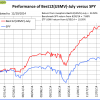- Prior to recession the yield curve becomes inverted, as indicated by the Forward Rate Ratio between the 2-year and 10-year U.S. Treasury yields (FRR2-10) being less than 1.00.
- Currently the FRR2-10 is about 1.20 signifying that US economic activity is in the expansion phase of the business cycle, far away from the next recession.
- When FRR2-10 falls to near 1.00 the transition from expansion to boom occurs. For the last seven recessions the average lead time after FRR2-10 becomes less than 1.00 was 14 months.
Blog Archives
The Forward Rate Ratio: A Long Leading Recession Indicator
The Unemployment Rate is Not Signaling a Recession: Update April 4, 2015
A reliable source for recession forecasting is the unemployment rate, which can provide signals for the beginnings and ends of recessions. The unemployment rate model (article link), updated with the March figure of 5.5%, does not signal a recession now.
Read more >
Timing the TIAA Real Estate Account
- In order to maximize returns one has to know when to enter and exit the TIAA Real Estate Account.
- Our analysis shows that a firm sell signal arises when its 1-year rolling return moves below 0%.
- A subsequent buy signal would be given when its 1-year rolling return moves from below to above 0%.
Vanguard Funds With Dynamic Asset Allocation: Three iM-Vanguard Systems
- iM-Vanguard Systems use a combination of Vanguard bond- and stock-funds, and switch assets according to stock-market climate.
- Backtests show that models using index funds produce better returns when a dynamic asset allocation strategy is employed (System1) than buy-and-hold.
- Higher returns can be obtained from actively managed Vanguard funds with dynamic asset allocation (System2 and System3). System3 uses only two stock funds and one intermediate-term bond fund.
The dynamic asset allocation strategy requires that during up-market periods more money is allocated to stock funds than bond funds, and during down-market periods more money is allocated to bond funds than stock funds.
Read more >
iM-Best(SPY-IEF) Market Timer: A Combination of Three Market Timing Models
- Stock market timing models usually provide discreet signals indicating whether to be in or out of the market.
- A better approach with potentially less risk is to stage investments over time when entering or exiting the market.
- Three market timing models with low correlation to each other are used in combination to provide staged signals, indicating stock market investment in 25% increments from 0% to 100%.
US Treasury Bonds: When Will the Panic Buying End?
- Currently the yield of 30-year US Treasury Bonds is at its lowest level ever.
- The bond-market rally which began at the beginning of 2014 is near its end.
- Some upside for long Treasury bonds is still possible, but not much.
The Unemployment Rate is Not Signaling a Recession: Update January 9, 2015
A reliable source for recession forecasting is the unemployment rate, which can provide signals for the beginnings and ends of recessions. The unemployment rate model (article link), updated with the December figure of 5.6%, does not signal a recession now.
Read more >
Is the Stock Market Overvalued? Estimating Returns to 2020 and Beyond
- Based on its historic trend, the stock market appears to be marginally overvalued.
- The historic trend suggests a probable real gain of about 20% over the next five years.
- Analysts’ long-term forecasts of stock returns made 3 years ago appear to have been unrealistically low.
- The Shiller Cyclically Adjusted Price to Earnings Ratio is relatively high (but not extremely high), and a market correction is possible.
Best8(S&P500 Min-Volatility) Large-Cap Portfolio Management System With S&P 500 Minimum Volatility Stocks
This model trades in highly liquid large-cap stocks selected from those considered to be minimum volatility stocks of the S&P 500 Index. It produced a simulated survivorship bias free average annual return of about 36% from Jan-2000 to end of Dec-2014.
Minimum volatility stocks should provide exposure to the stock market with potentially less risk, seeking to benefit from what is known as the low-volatility anomaly. Consequently, they should show reduced losses during declining markets, but should also show lower gains during rising markets. However, our backtests show that better returns than the broader market can be obtained under all market conditions by selecting 8 of the highest ranked stocks of a universe made up from minimum volatility stocks of the S&P 500.
Minimum Volatility Stocks: Out-Of-Sample Performance of iM’s Best12(USMV) Buy&Hold Models

The backtest reported in this article showed that ranking the holdings of USMV, the iShares MSCI USA Minimum Volatility ETF, and selecting a portfolio of the 12 top ranked stocks, provided higher returns for the buy&hold portfolio than for the underlying ETF. To test these findings out-of-sample we launched the Best12(USMV)-July-2014on Jun-30-2014 and the first sister model Best12(USMV)-Oct-2014 on Sep-29-2014. Holdings and performance have been published weekly on our website since then. So far to Dec-15-2014 these portfolios have gained 19.2% (6.8%) and 10.5% (5.3%), respectively. (USMV gains are in brackets.) The test will be expanded by the launch on Jan-5-2015 of the second of the three sister models quarterly displaced, the Best12(USMV)-Jan-2015, which again will consist of the 12 highest ranked stocks of the then point-in-time holdings of USMV.
Read more >
